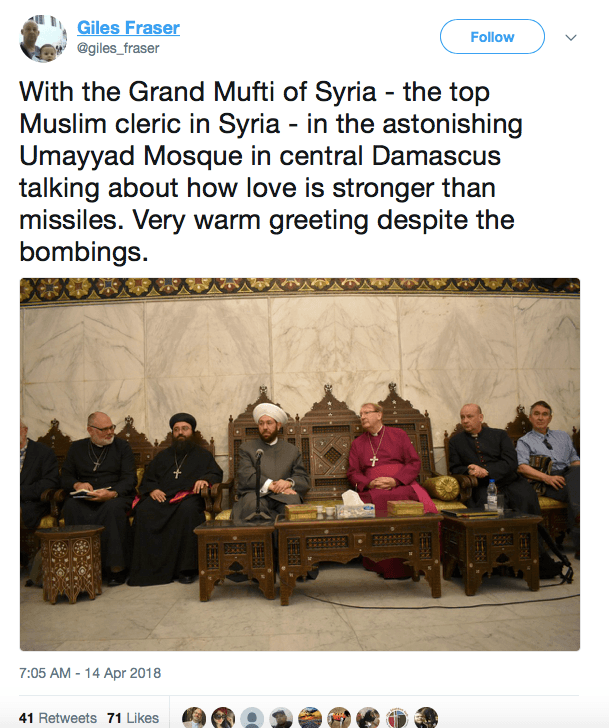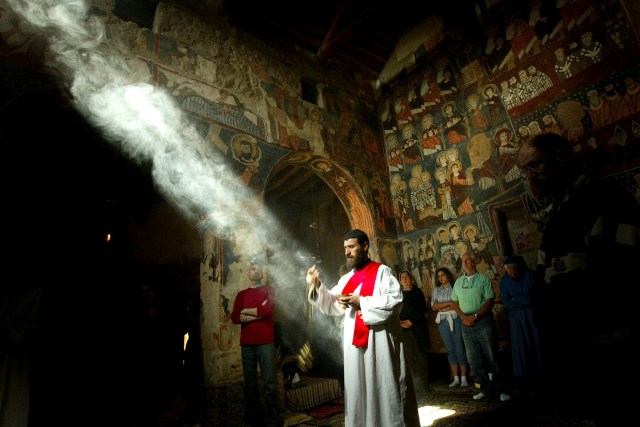Brother Putros, a Syrian monk, swings incense durring mass in the church of the Monastery of St. Moses (Photo by Ghaith Abdul-Ahad/Getty Images)

The phrase “Come and see”, occurs twice in St John’s Gospel. In the opening chapter, Jesus says, “Come and see”, to two followers of John the Baptist. And it was the very phrase the Patriarch of the Syrian Orthodox Church, Ignatious Aphrem II, used in welcoming us to Damascus. “Come and see!” he boomed. Come and see the suffering of the Christian community; come and see what this place is really like – knowing also that his audience of clerics would get the Biblical reference.
But what were we being shown? And how much of it could we believe? On Sunday morning, the Patriarch preached, in Arabic and then in English, about the scepticism of Doubting Thomas. In a police state such as Syria, it can be hard to know what the truth is – perhaps especially – when you are visiting. The critical independence of Doubting Thomas was going to be much needed out here. The Syrian churches made a joint statement condemning Friday night’s bombing by the US, the UK, and the French. The Patriarch read out the statement to us. “Brutal aggression”, he called it. Maybe he believed that; maybe he had to say it. The security services, the dreaded Mukhabarat, were no doubt sitting at the back.
Out in the Christian quarter of Damascus they were talking a lot about bombing – but not the allied bombing of nearby air bases, rather the recent end to the shelling that had been going on from Eastern Ghouta, a Damascus suburb. The allied attack was just a “firework display”, they said.
But the end of the mortar shelling of their houses and streets from ISIS based out in Ghouta, they really did care about. And whatever they really think about the Assad regime, this much was plain to see: they regard Assad and the Syrian Army as the only things standing between them and murderous Islamic jihadists such as ISIS. And, given this choice, Assad is the lesser of two evils. “I thought the west was supposed to be fighting Da’esh” one woman asked me, genuinely puzzled “so why are they helping Da’esh by fighting us?”
The Syrian Orthodox church can trace its origins to the earliest movements of the church. It still prays in Aramaic, the language that Jesus prayed in. And its cathedral is on Straight Street in the old city, the Roman street that a blinded St Paul (then still Saul) was led through after his dramatic road to Damascus experience. This is Christianity in its birthplace. And yet the Syrian church feels neglected and unloved by the rest of the Christian world. “People are too frightened to come here and they don’t know what it’s like” one of the priests explained to me.
Earlier that day, we had been in the astonishing Amayyad Mosque in Damascus, one of the holiest sites in the Muslim world, and were shown the tomb, right in the middle of the prayer hall, where the head of John the Baptist is supposed to be buried. It was impossible not to be reminded of all those who have been beheaded by ISIS up in the north and over in the east of Syria. The Grand Mufti took the Patriarch by the hand and led our group out into the Mosque courtyard to show us around. There seemed to be genuine affection between the two men. Was this how to understand inter-faith relationships in Syria: the Patriarch and the Grand Mufti holding hands?

The Grand Mufti, Syria’s leading cleric, embodies the complexity of the civil war in Syria. Last year, Amnesty International published a report accusing him of being a signatory to thousands of deaths in Sednaya prison, just outside Damascus. Others have disputed Amnesty’s findings. Certainly, he is a loyal Assad supporter. And, yet, also a theological moderate who speaks of peace, of Christians, Muslims and Jews being “all made from the same earth”. As he told the European Parliament in 2008: “Abraham, Moses, Jesus and Mohamed came with one single religion … there is no holy war, because a war can never be holy: it is peace that is holy.” Words are cheap, you may say. But three years after that Islamic jihadis in Aleppo murdered his youngest son.
As we were out in Syria, there were those back home in England attacking us for making the trip. We were drinking tea with mass murderers. We were being used as Assad stooges, they argued. Writing in The Times about our meeting with the Grand Mufti, David Aaronovitch asked: “Did you know where his hand had been, Giles, when you shook it?”
I really question how much propaganda value the Assad regime can really squeeze out of a visit from the vicar of a small parish in south London. The rest of the group included journalists, artists, academics and clerics. And there were moments of real tension when the journalists in our group rightly challenged the pat regime narrative that so many of the people we met had clearly swallowed.
Sitting in the Syrian Parliament, surrounded by Assad placemen, the brilliant young reporter Gareth Brown – a sometime stringer for The Times in the Middle East – kept on asking, and asking, about the use of chemical weapons. You could tell how much they hated it. He embodied the spirit of Doubting Thomas, a noble journalistic aim.
But David Aaronovitch was right. Of course there is a risk in talking to people who may have done terrible things. Even so, journalists do it all the time. And so do priests. We went to Syria at the invitation of the Syrian Church to learn more about the conditions under which they operated. The persecution of Christianity in the Middle East, in its birthplace, is something many people are rightly concerned by. “Come and see!” said the Patriarch. And we did.
The civil war in Syria is brutal and horrific. I have no doubt that atrocities have been committed by the government and the jihadis. But according to the Christians I spoke to, that is the choice they face – Assad or ISIS – since the moderate rebels were subsumed by the militants some time ago. Among the many tragedies here is the fact that any legitimate criticism of the Assad regime is labelled as terrorist propaganda, and treated accordingly. Which means that even the so-called opposition politicians we met were loyal Assadists. But if Assad were all that stood between my family and ISIS, I wonder if I too might hold my nose and wave the Syrian flag.
Certainly, the Assad supporters we met talked a good game about religious pluralism. When David Miliband, then Foreign Secretary, visited Syria in 2008, he met many of the same people we did, including the Minister of Religious Affairs. The same Minister spoke to us about the desperate need for a moderate Islam. He went through the de-radicalisation pamphlets they have been distributing in schools – a Syrian version of our Prevent strategy. And Christians exist at all levels of government. I describe them not to praise them, but simply to explain what we are dealing with.
If these are the bad guys, they are the bad guys the British government will one day have to deal with, as they are clearly winning in Syria. There is no prospect of allies using ground troops to change the situation in Syria – and to change it in whose favour?
Instead, we went for bombing. For being seen to act. It was little more than right-wing virtue signalling, designed for domestic applause and, if anything, it rallied more people to the Assad cause. Typically Trump. For all our big talk about the war on terror, it is largely the Syrian army – with the Russians and the Iranians – that has defeated ISIS and other militants in Syria. The allied bombing of Syria the other night did nothing to bring peace any closer.
Meanwhile, the churches try and survive in this most impossible of contexts. Are they morally compromised by their closeness to the regime? Probably. Do I understand why they do it? Of course. Like every one else in this horrific war, they are struggling to survive. And they just want the war to end.
On the wall of the Syrian Orthodox Cathedral is a mural remembering the Assyrian Genocide that took place in the early part of the 20th century. In 2007, the International Association of Genocide Scholars agreed that the “Ottoman campaign against Christian minorities of the Empire between 1914 and 1923 constituted a genocide”. The Syrian church estimates that 90,000 Christians were murdered, 345 villages burned, and 156 churches destroyed.
This is the back story to the Syrian church’s attempt to survive. ISIS and al-Quaeda are the latest in a long line of people that have tried to wipe them out. Our group made a pastoral visit to the long-persecuted Syrian church. I am glad that we went, despite all the obvious risks of our trip being misrepresented. And they were glad that we came and listened.










Join the discussion
Join like minded readers that support our journalism by becoming a paid subscriber
To join the discussion in the comments, become a paid subscriber.
Join like minded readers that support our journalism, read unlimited articles and enjoy other subscriber-only benefits.
Subscribe